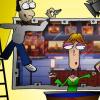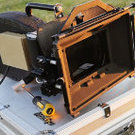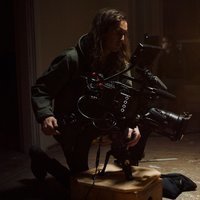-
Posts
106 -
Joined
-
Last visited
Profile Information
-
Occupation
Director
-
Location
Idaho
Recent Profile Visitors
4,982 profile views
-

Good Old Fashion Light Meter
Stephen Baldassarre replied to Stephen Baldassarre's topic in Lighting for Film & Video
I figure out the camera settings I want and light to that. I'd be hard pressed to get satisfying results shooting in anything less than about 60 Lux. -
I use panel lights a lot because I'm generally either creating very flat lighting with no obvious shadows and then adding a key to create a single, distinct shadow, or otherwise using the panels to fill in shadows when utilizing available light. Those Amarans with soft boxes could achieve a similar result (then adding one without a soft box for the key). I haven't worked with them personally though. I actually don't have any LED spots, as I like having real tungsten as my key for better color rendering.
-
Check out some of the old Kodak film brochures. Many of them have screen shots from actual theatrical films and what the relative exposure is for different parts of the frame. That'll help you develop a baseline for looking at other images. I seem to remember an engineer from Kodak sending me a book with a handful of images and relative exposures notated in them. I think I lost it years ago though. Kodak also has a great deal of material on YouTube. Check out the following video, around 11:08
- 4 replies
-
- 1
-

-
- lighting ratios
- lut
-
(and 1 more)
Tagged with:
-
That would be a decent start, though if I were a student on an extremely limited budget (as I was once), I would get a set of obsolete tungsten lights that theaters, clubs, churches etc. are throwing away. I STILL bring out my old ETC PAR lights and DeSisti 1K Fresnels. I'll often set up an arc of fill lights with panel lights, like FotodioX Pro LED P60 to bring my exposure up to maybe -1 stop, no shadows, then add in a 575W PAR with oblong lens or a 1K Fresnel for the key to bring exposure up to full. I have some relatively tall but inexpensive stands like Impact Pro 10'8" stands, among others, but I also have some nice hefty 14' C-Stands. If you do wind up getting those Amarans, I would strongly suggest soft boxes to go with them.
-

Good Old Fashion Light Meter
Stephen Baldassarre replied to Stephen Baldassarre's topic in Lighting for Film & Video
My first light meter was (and still is) an old GE I bought from a clerk at a local camera store for $5. I mean, it was his personal first light meter and sold it to me when I was in high school. It still works and is fairly accurate, but just measures footcandles, which you enter into a rotary computer on the case. I have an old, lower-end Sekonic that does similarly, but I like the Gossen better. Now here's another consideration: I've heard a few people say that older meters don't play well with LED lighting. I still work primarily with tungsten lighting but I do a some hybrid stuff as well and never noticed a difference. I tried looking up the spectral response of silicon photocells but it gets kind of murky. Some types are noticeably more efficient in the blue end of the spectrum, others are fairly flat across the spectrum. I suppose I could grab an RGB light and test to see which flavor my meter has. -
It depends on the projector and the shutter angle. DLPs can introduce colored flicker, LCDs generally won't. The narrower the shutter angle, the worse the flicker will be. LASER and LED are just light sources, as opposed to the various other types of lamps projectors commonly use. The lamps are not a source of flicker, just the imaging technology, as many DLPs use spinning color wheels to sequentially isolate red, green and blue. If I could choose my projector, I'd probably prefer a 3-LCD projector with halogen lamp, as that would *generally* render best on film. I'm assuming you're using tungsten-balanced lighting as well. LED and LASER are likely going to be 5600K or higher, so they'll look blue on-cam, relative to tungsten lighting.
- 1 reply
-
- 1
-

-

Good Old Fashion Light Meter
Stephen Baldassarre replied to Stephen Baldassarre's topic in Lighting for Film & Video
That actually doesn't bother me. I put the meter in front of my face and point forward, click, then look at the meter. Since it retains the reading for a few seconds, I have time to turn the dial afterwards. Sometimes when I'm lighting for stage, I'll turn it sideways and point it towards the audience while I walk across the stage, holding the button to see the needle move, VERY HANDY! I've been suspecting I might have to bite the bullet on this one and "modernize". I feel like a simple software update could make a newer meter do what I want though. -

Augmenting In-Shot Practicals
Stephen Baldassarre replied to Olivier Metzler's topic in Lighting for Film & Video
I generally add an arc of comparatively low-power lights to add fill or possibly bounce a spot off of a large card or white wall to fill the shadows a little. -
I have several light meters but have an affinity for the Gossen Luna Pro SBC. I currently have two of them but they won't last forever; I broke one a year ago by dropping it on a concrete floor. They're mechanical devices, the domes on some units I see online are obviously yellowed and mine will probably do the same over time. The thing about this meter: you can take a reading, turn the dial till the needle reaches "0", then every combo of F-stop and shutter speed on the dial will yield a good exposure. What makes this my favorite meter is I can have the dial set and click the button to see "+1.5 stops", or take reflected light readings to see how highlights/shadows will render. I can go on-scene and set the meter for say, 100 ISO, 1/60, F4 and the meter will simply show how many stops over/under I am in a given area. Now I know you can SORT of do that with modern meters but they all seem to do it in a less intuitive way. Like, instead of saying "-1" when I want to light for F4, it'll say F2.8. Also, I don't like navigating menues or click through options to get it to behave the way I like (I knew a DP that just set his meter to show Lux and didn't bother with anything else). The dials just stay where I put them. It's a minor nit pick, I get it, but I feel I can work more comfortably with a meter that's older than I am than the newer ones I've used. Do any of you know of a MODERN meter that shows relative exposure in stops?
-
This was from a 16mm shoot, many many years ago. I think the stock was 7205, 24fps, T2, no filters or artificial lighting. The first movie I directed had a fireplace scene, indoors. I shot it on 200 ISO at F2 as well, though it was a smaller fire and the subject was closer to it. I'm afraid I don't have a screen shot at the moment. You can put silver reflectors nearby to add some fill.





